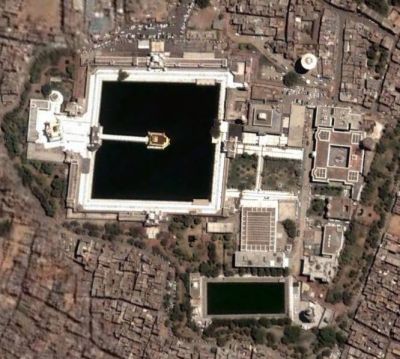« Char Dham Yatra - 2 | Main | An Adventure in Morocco »
July 17, 2005
The Golden Temple at Amritsar
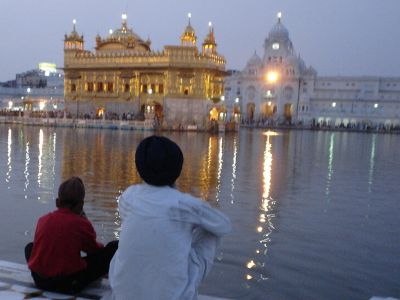
The Golden Temple, at Amritsar
Hi to all my readers! I'm back home again now, and have been able to get a few more photos from the digital camera put online for everyone to look at. These were all taken in Amritsar, which is a large city in the Punjab, and the site of the holiest of Sikh temples, the Golden Temple.
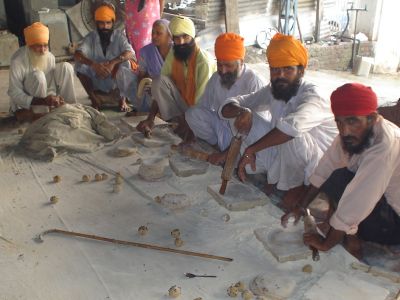
The Chapati Team - 1
In keeping with the Sikh philosophy of tolerance and friendliness, everyone is welcome to visit the temple, participate in the services, or help out at the various daily tasks that assist the running of the temple. Like all Sikh temples or Gurudwaras, the Golden Temple has its own community kitchen and dining hall, where all temple visitors, regardless of their religious beliefs, can eat together.
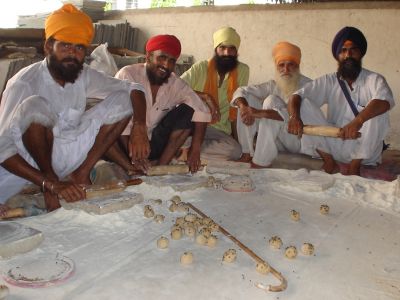
The Chapati Team - 2
The third Guru, Amar Das (1552-74) abolished the custom of eating only with others of the same caste, and Amar Das even refused to bless the Moghul Emperor Akbar unless he was prepared to eat with everyone else who was present. The kitchen at the Golden Temple, known as the Guru Ram Das Langar, feeds up to 10,000 people a day, with over 3,000 at each sitting. A simple meal of spicy lentils, known as dhal, with wheat-flour chapatis, and a drink of water, is served free of charge to anyone who wishes to come ot the dining hall.
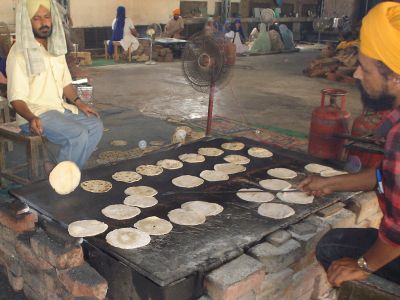
Cooking the chapatis
Voluntary Service, which continues to be a feature of modern Sikhism, extends to the kitchen staff and workers, who have a busy time ahead of them preparing food for so many people, and then washing up the dishes, cups, and spoons afterwards. Although foreigners rarely join in with this work, it was for me an important task to help along with the other pilgrims, as I have great respect for the Sikhs, and all that they represent.
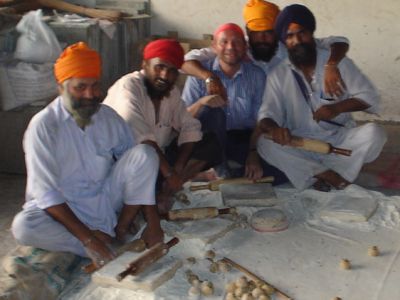
A beginner joins the team!
I joined the Chapati Team, who prepare the thousands of chapatis needed for each sitting. The dough arrives from the mixing area in large baskets, where it is then divided into small pieces and rolled into balls about 4cm in diameter. These balls are then passed down the large white cloth, around which everyone sits on their haunches, to the men and women who roll the chapatis out. Each person has a small white marble board, and a wooden rolling pin. Beside the board is a pile of flour. The ball of dough is squashed slightly, dipped in the flour, then rolled out in a couple of deft movements to form a perfectly round chapati for the pile. Despite my practice, both before coming here and whilst I was here, it still took me three times as long to make each chapati as the regulars! It was amazing to watch the skill and speed these guys used to turn out chapatis so quickly.
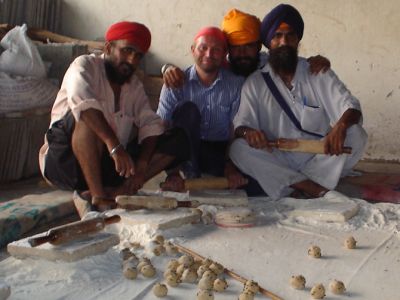
Some of mine were round!
The chapatis are then cooked on improvised hot-plates made from a large rectangle of 2cm thick steel, heated from below by gas burners. One man would collect the pile of freshly rolled chapatis, try not to grin when he saw mine, and then deftly toss them in a neat line on to any empty space on the hot plate. Another man, using a long piece of thick wire with a bend at the bottom, would then flip them over when the first side was done, and then flick them off the hot plate to a waiting basket. This all happens very fast, and is done with great skill and nonchalance - I was most impressed!
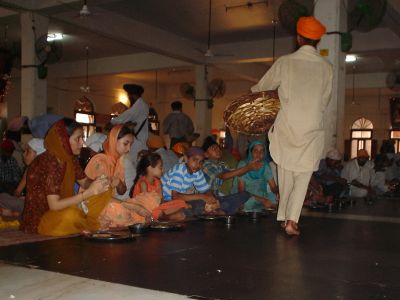
In the dining hall - chapatis handed out
The piping-hot chapatis are then taken to the nearby dining hall, where the diners are seated on mats ready for their meal. They are given a plate, a cup, and a spoon at the door, and then when seated, are served by volunteers with their simple meal of dhal, chapatis, and a drink of water. Seconds are available on request. Most Indians prefer to eat with their fingers, tearing off small pieces of chapati with their right hand, and using each piece as an edible-scoop for the tasty lentil dhal. After eating, the plate is wiped clean with the last piece of chapati. The used dishes are handed in at the door on the way out.
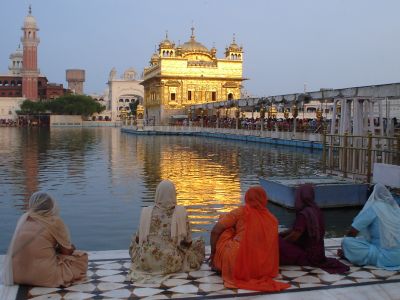
Evening worship
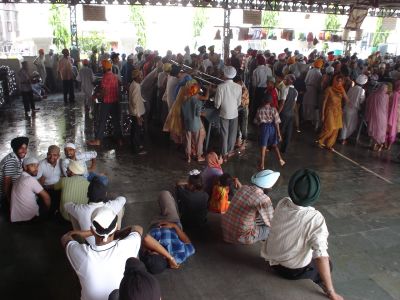
The washing-up hall
The used dishes, spoons, and cups are then taken in large bins to the washing-up hall, a large area filled with long sinks full of water. The dishes are washed and rised in a number of stages that ensure that everything is spotlessly clean, ready for the next meal. All the plates and cups are made of stainless steel, so there is no risk of breakages!
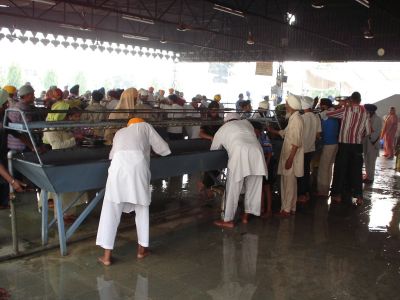
Washing up - 1
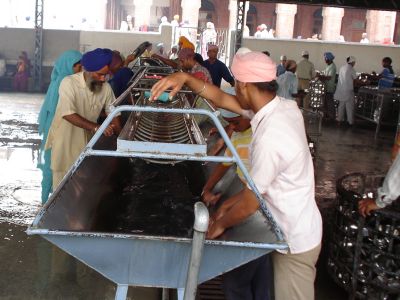
Washing up - 2
After washing and rinsing, the dishes are quickly drained, then neatly stacked away in huge wheeled storage bins, ready to be used again at the next sitting. The washing up is all done by volunteers, both men and women. I joined in as well - what a wonderful communal atmosphere the Golden Temple and the Sikh religion has; one that could be copied with great benefit for any of the other world religions and peoples.
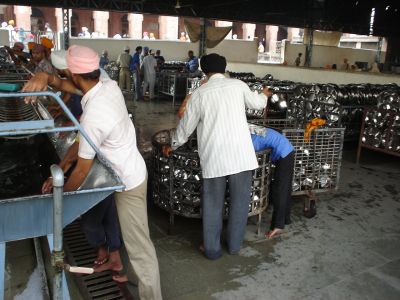
Dishes cleaned for the next meal
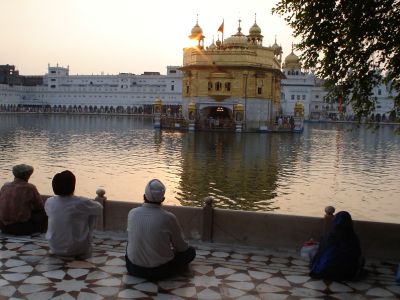
Evening worship
Each evening, the Golden Temple is lit by floodlights - such a beautiful scene. The evening prayers take place at 8pm. Worshippers sit all around the perimeter of the water-filled 'tank' that surrounds the Golden Temple, and the services from inside are broadcast over loudspeakers so all can hear and join in. The worship is filmed as well for TV, and is rebroadcast on a number of satellite channels - perhaps you can check your own satellite receiver, and see if you can watch as well.
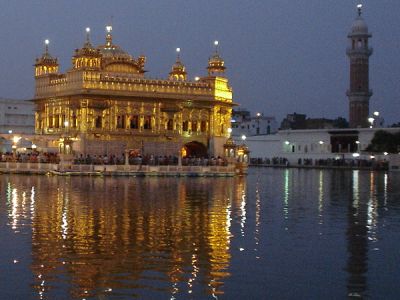
Closeup of the Golden Temple
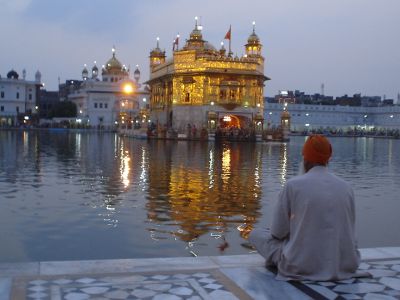
Evening worship
Here's a view of the Golden Temple that I extracted from Google Earth. Click on the image to see a bigger picture, which will open in a new browser-window.
Posted by travellingtim at July 17, 2005 01:37 AM

